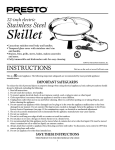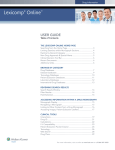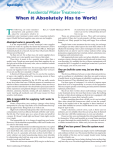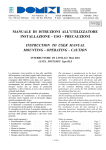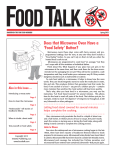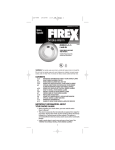Download Maple Chase COQ6 Owner`s manual
Transcript
110-729C 10/3/00 2:08 PM Page 1 Owner’s Manual COQ3 — 120V AC Direct Wire COQ6 — 120V AC Direct Wire with 9V Battery Backup 110-729C Thank you for purchasing a Firex carbon monoxide alarm. It is an important component of your home security system. Please read this booklet thoroughly. The more familiar you are with the information it contains, the easier you will find it to install, operate, and maintain your carbon monoxide alarm properly. This ultimately means greater security and peace of mind for you and your family. The Maple Chase Company Table Of Contents 2 The Dangers of Carbon Monoxide (CO) Models COQ3 and COQ6 2 CO Alarm Features 3 Where to Install Your CO Alarm 4 How to Install Your CO Alarm 5 How to Operate Your CO Alarm 6 What to Do if the Alarm Sounds 6 Maintenance and Cleaning 6 Replacing the Battery (Model COQ6 only) 7 Troubleshooting 7 Symptoms of Carbon Monoxide Poisoning 8 Home Safety Tips 8 Limited Warranty 110-729C 10/3/00 2:08 PM Page 2 The Dangers of Carbon Monoxide Carbon Monoxide (CO) is a toxic gas. It cannot be seen, felt, tasted, or smelled. The effects of CO poisoning can cause household members to become extremely ill or even cause death. Due to damage, poor maintenance, or defects, many appliances like furnaces, ovens, fireplaces, kerosene heaters, and grills may silently emit CO. Advance warning of CO poisoning is only possible if you install and maintain a CO detection device. The amount of CO in the air is measured in parts per million (ppm). Carbon monoxide occurs when fuel burns without sufficient oxygen (incomplete combustion). This type of malfunction can happen to any fuel-burning appliance at any time. Many fireplace chimneys, for example, can become filled with leaves during the fall season. If enough leaves, dirt, and soot are accumulated in the chimney, proper ventilation will be interrupted. This can cause a backdraft of CO into the home. The result can be fatal. With proper maintenance and cleaning, however, the potential for CO build up can be reduced. Carbon monoxide poisoning is a serious issue. Many families suffer daily, and over one thousand lives are lost each year because of this deadly household gas. With proper maintenance and care, this CO alarm can give family members advance warning to CO emissions. Please read this manual thoroughly to learn how to properly install, operate, clean, and repair your CO alarm, and for important safety tips to safeguard your family from deadly CO poisoning. The following symbols identify the most important safety messages in this manual. ! DANGER When you see this symbol, be aware! that if the message is ignored, the hazard WILL result in SEVERE bodily injury or death. ! ! WARNING When you see this symbol, be aware!that if the message is ignored, the hazard CAN cause SEVERE bodily injury or death.! ! CAUTION When you see this symbol, be aware! that if the message is ignored, the hazard CAN or WILL cause MINOR bodily injury. ! WARNING BE AWARE OF COMMON SOURCES OF CARBON MONOXIDE. Common sources of carbon monoxide are furnaces, heating devices, water heaters, gas ! stoves, kerosene heaters, fireplaces, barbecues used indoors, running motors or engines in attached garages, and gasoline powered devices, such as generators or pumps used in emergency situations. Be aware of the proper uses for each device. Have these devices serviced and cleaned regularly. Use common ! instructions carefully whenever using any sense, and follow safety and hazard of these devices. ! WARNING Individuals with medical problems may consider using warning devices that provide audible and visual signals for carbon monoxide concentra! tions under 30ppm. CO Alarm Features • 9V battery backup (Model COQ6 only). • Quick connect wiring harness for fast, easy installation. • Square shape, easily distinguishes from smoke alarm. • Large TEST/RESET button—easy to use. • Three level light and sound alarm system—you always know if: 1. AC power is applied to the unit. 2. Your alarm requires immediate replacement. 3. CO levels are dangerous. • Electrical Rating: 120V AC, 60Hz, 0.05 amp 2 110-729C 10/3/00 2:08 PM Page 3 ! CO Alarm Features cont. ! WARNING This CO alarm is designed to detect carbon monoxide gas from any source of combustion. It is NOT designed to detect smoke, fire, or any ! other type of gas. If this CO alarm sounds its alarm horn, DO NOT ! alarm horn requires your immediate assume that it is a false alarm. The action. ! WARNING This product is intended for use in ordinary indoor locations of family living units. It is not designed to measure compliance with Occupational Safety ! and Health Administration (OSHA) commercial or industrial standards. ! Where to Install Your CO Alarm ! WARNING Carbon monoxide gas can be anywhere and everywhere. CO gas is equal to or slightly lighter than air, and disperses evenly with the air in a room. ! Therefore, install this CO alarm where air circulation is best. DO NOT mount the CO alarm within 1 foot of the ceiling/wall or wall/wall intersection, or other dead air spaces. Since most CO fatalities occur while families are sleeping, we recommend that you install at least one CO alarm in the hallway outside each separate sleeping area and one inside each bedroom or sleeping area. ! We also recommend that you install a CO alarm on every separate living level of the home where household members frequently spend ! time, as well as in the basement. See figures 1, 2, and 3 for typical CO alarm locations within the home. ! CAUTION This alarm will only indicate the presence of carbon monoxide gas at the sensor. Carbon monoxide gas may be present in other areas. LIVED-IN ATTIC BEDROOM BATH BEDROOM BEDROOM BATH BEDROOM FAMILY / GREAT ROOM BEDROOM BEDROOM KITCHEN LIVING ROOM BASEMENT KITCHEN FURNACE ROOM FURNACE ROOM BASEMENT single story FIGURE 1 BATH BATH LIVING ROOM BASEMENT UTILITY ROOM two story FIGURE 2 ! FIGURE 3 split level Key CO alarm locations ! WARNING DO NOT install CO alarms: • Near bathrooms or in shower areas. Steam and aerosol sprays can ! disable the alarm. • In closets, crawlspaces, unused attics, or unheated areas where surrounding air temperatures may go below 40° F (4.4° C) or above 100° F (37.8° C). • Within five feet of any fuel-burning appliance (stove, kerosene heater, furnace, fireplace, etc.). • Within one foot of any wall, corner, or other dead air spaces. • In rooms where chemicals or cleaning supplies are frequently used (paint, hair spray, thinner, etc.). Allow plenty of ventilation in rooms where chemicals are used. • Directly above a sink, bathtub or basin. • Directly above or below air exchange or heating vents. • Behind drapes, furniture, or appliances that could block air flow to the CO alarm. 3 110-729C 10/3/00 2:08 PM Page 4 ! ! WARNING This unit cannot be used in recreational vehicle applications. ! Alarm How to Install Your CO ! ! WARNING ELECTRICAL SHOCK HAZARD. Turn off power at the main fuse box or cir! cuit breaker by removing the fuse ! or switching the circuit breaker to the OFF position. ! CAUTION Check local codes for specific mounting requirements in your area. Once you have decided the best place to install the CO alarm(s), follow these steps: 1. From back of CO alarm, slide mounting plate and lift from base. See Figure 1. 2. For Model COQ6 only: Connect new 9-volt battery to battery connector inside compartment and slide door closed snapping it into place. New 9V battery comes from the factory installed backwards inside the battery compartment. Replace battery with Eveready 216, 522, 1222 or equivalent from your local retailer. FIGURE 1 3. Align mounting plate with junction box mounting holes. 4. Gently pull household wires through center hole of mounting plate. 5. Secure mounting plate to junction box. 6. With a small wire connector, connect white wire from the CO alarm to white household wire. 7. Connect black wire from the CO alarm to the black household wire. 8. For interconnecting CO alarms only: • Use #18 AWG minimum solid or stranded wire. When interconnecting, maximum wire length between any two units is 1,500 feet for #18 AWG or 4,000 feet for #14 AWG (20 OHMS loop resistance.) See Figure 2. WHITE BLUE BLACK WHITE BLUE BLACK WHITE TO NEUTRAL BLACK TO 120 VAC (HOT) FIGURE 2 • This CO alarm may be interconnected with as many as 11 other Firex CO alarms of the same model. DO NOT connect to any other type or model CO alarm or other device. • Connect CO alarms to a single AC branch circuit. If local codes do not permit connection to a single AC branch circuit, be sure the neutral wire is common to all circuits used. 9. Plug wiring harness clip onto pins on the back of the unit. 10. Align tabs on back of base with slots on side of mounting plate. Slide base down to lock into position. See Figure 3. 11. Turn power on at the main fuse box or circuit breaker. The CO alarm will flash the red LED and emit a short beep during its power-up cycle. The green POWER light will stay on as long as the CO alarm is receiving AC power. 4 FIGURE 3 110-729C 10/3/00 2:08 PM Page 5 How to Install Your CO Alarm cont. 11. Firmly PRESS AND RELEASE THE RESET/TEST button. See Figure 4. The alarm should sound a short tone. The amber SERVICE light will turn on, and the CO alarm will go through its test cycle. The red LED will flash, and the alarm will beep four times followed by 5 seconds of silence and then repeat the cycle. After the test cycle, amber SERVICE light will turn off, and the green POWER light will remain lighted which means that the CO alarm is operating properly. PRESS IN, HOLD, AND RELEASE TO RESET AND/OR TEST. FIGURE 4 12. If the alarm is interconnected to other CO alarms, press and hold the RESET/TEST button until the red light turns on. Other interconnected alarms will also beep four times followed by 5 seconds of silence. The red ALARM light on other alarms will not light during this test. 13. Two self-adhesive labels have been provided with instructions indicating what to do if the alarm sounds. Add the phone numbers of your emergency services provider and a qualified technician to each label. Place one of the labels in a visible area next to the alarm, and place the other label near a source of fresh air which will be used as a gathering place if the alarm sounds. How to Operate Your CO Alarm This carbon monoxide alarm has been evaluated by UL and meets the applicable UL standards and requirements. This CO alarm has a three light and sound alarm system: CARBON MONOXIDE ALARM ON SERVICE ALARM: MOVE TO FRESH AIR On Green indicator constantly ON indicates unit is receiving AC power. Service Amber indicator flashing and alarm horn beeping every thirty seconds indicates “Unit Fault.” Press and release the TEST/RESET button. If the alarm returns to displaying the fault signal, the CO alarm is not operating properly. REPLACE THE CO ALARM IMMEDIATELY. SEE THE WARRANTY INFORMATION AT THE END OF THIS MANUAL. Alarm Red indicator flashes and alarm horn sounds four fast beeps and then is quiet for 5 seconds. (Power on/operating) (Problem with Alarm) (Dangerous CO levels) Low Battery The unit will emit a chirp once every 30 seconds when the battery is low (For COQ6 only) and needs to be replaced. When the CO concentration builds to a level that is equal to 70 ppm or greater for the duration identified within the standard, the following will occur: • The ALARM light and sound signals will activate. See the “What To Do If Your Alarm Sounds” section of this manual for important action steps to be taken. • If you wish to press the TEST/RESET button during this time, the alarm will become quiet for approximately four minutes. The ALARM signals will be reenergized within 4 minutes from the time the reset button is pressed if the concentration of carbon monoxide surrounding the alarm remains at 70 ppm or greater. • The alarm will remain silent if the CO concentration has decreased below the alarm level of the standard. See the “What To Do If Your Alarm Sounds” section of this manual for important action steps to be taken. • The alarm will continue for as long as the condition exists. The alarm will not permanently end its ALARM mode until the concentration of CO has been reduced to a safe level. 5 110-729C 10/3/00 2:08 PM Page 6 Test Your CO Alarm Weekly Momentarily press the TEST/RESET button and note the alarm sound. Also note that the LED indicators flash the proper test sequence as described in “How to Install Your CO Alarm.” If the alarm does not beep after depressing the TEST/RESET button or exhibit the correct LED test sequence, immediately return the CO alarm to Maple Chase for repair or replacement. See the warranty information at the end of this manual. Do not attempt to repair the unit yourself as this will potentially cause damage and void the warranty. ! What to Do if the Alarm Sounds !! WARNING Carbon Monoxide cannot be seen, felt, tasted, or smelled – but it can be FATAL. ! ! WARNING IF THE RED ALARM LED INDICATOR IS FLASHING AND THE ALARM IS SOUNDING APPROXIMATELY EVERY FIVE SECONDS, IT INDICATES THE PRESENCE OF CO WHICH CAN!BE FATAL. YOU MUST QUICKLY DO THE FOLLOWING: 1. Operate TEST/RESET button; 2. Call your emergency services [fire department or 911]; 3. Immediately move to fresh air — outdoors or by an open door/window. Do a head count to check that all persons are accounted for. Do not reenter the premises nor move away from the open door/window until the emergency services responders have arrived, the premises have been aired out, and your alarm remains in its normal condition. 4. After following steps 1 – 3, if your alarm reactivates within a 24 hour period, repeat steps 1 – 3 and call a qualified appliance technician (_________________) to investigate for sources of CO from fuel burning equipment and appliances, and inspect for proper operation of this equipment. If problems are identified during this inspection have the equipment serviced immediately. Note any combustion equipment not inspected by the technicians and consult the manufacturer’s instructions, or contact the manufacturer directly for more information about CO safety and this ! equipment. Make sure that motor vehicles are not, and have not been, operating in an attached garage or adjacent to the residence. ! WARNING If the CO alarm sounds its alarm horn again, it has sensed CO. This is not a false alarm. ! Maintenance and Cleaning This CO alarm does not require any maintenance, except occasional dusting or cleaning. If necessary, occasionally vacuum the case of the CO alarm. To clean the CO alarm, unplug each CO alarm from its wiring harness and use a damp cloth to clean the OUTSIDE of CO alarm case. DO NOT remove cover or attempt to clean inside the CO alarm. Dry the cover completely and plug each CO alarm back onto ! the wire harness and replace on the mounting bracket. Press in, hold, and release TEST/RESET button on each CO alarm to test after cleaning. ! WARNING Do not use abrasive cleansers, or spray the CO alarm with cleaning agents or waxes, especially cleaners containing ammonia. These liquids may impair ! the performance of sensors. Do not submerge the CO alarm in water. Replacing the Battery (for Model COQ6 only) 1. 2. 3. 4. 5. Turn off power at main fuse box or circuit breaker. Slide alarm in direction of arrow on side of unit to remove from bracket. Disconnect wire harness from back of unit. Open battery compartment and replace battery. Reattach wire harness to unit and replace on mounting bracket. 6 110-729C 10/3/00 2:08 PM Page 7 Troubleshooting Problem: The alarm is properly connected to AC power, but the green LEDs do not light. Solution: Return alarm to Maple Chase Company for service (see warranty). Problem: Amber Fault light flashes every 30 seconds Solution: Press the Test/Reset button to allow the alarm to re-check itself internally. If the AMBER LED continues to flash, the alarm must be returned to Maple Chase Company for service (see warranty). Problem: The alarm makes a chirping sound (Model COQ6 only). Solution: The battery needs to be replaced (see “How to Operate Your CO Alarm”). Symptoms of Carbon Monoxide Poisoning Carbon monoxide poisoning has many symptoms. However, some symptoms are very similar to flu symptoms, the effects of intoxication, or drug usage. In many CO cases, people feel ill and stay home to rest. This only compounds the CO poisoning because they stay in the home where CO is present. As CO levels rise, the symptoms become more extreme. At low levels people will suffer headaches and mild nausea. At higher levels unconsciousness, heart failure, and even death can occur. The following symptoms are related to CARBON MONOXIDE POISONING and should be discussed with ALL members of the household: Mild Exposure: Slight headache, nausea, vomiting, fatigue (often described as flu symptoms). Medium Exposure: Severe throbbing headache, drowsiness, confusion, fast heart rate. Extreme Exposure: Unconsciousness, convulsions, cardio-respiratory failure, death. Many cases of reported CARBON MONOXIDE POISONING indicate that while victims are aware they are not well, they become so disoriented they are unable to save themselves by either exiting the building or calling for assistance. Also, young children, the elderly, and household pets may be the first affected by CO poisoning. The important factor with any CO poisoning, however, is time. At high levels, CO can cause death in just minutes. At lower levels, it could take from hours to days of constant CO exposure to have the same life-threatening effect. The chart below illustrates the symptoms of CO poisoning by concentration of CO and its effect over time. Slight headache within 2-3 hours. Frontal headache within 1-2 hours. Dizziness, nausea, and convulsions within 45 minutes. Insensible within 2 hours. Headache,dizziness and nausea within 20 minutes. Death within 2 hours. Headache,dizziness and nausea within 5-10 minutes. Death within 30 minutes. Headache,dizziness 1-2 minutes. Death in less than 15 minutes. Death in less than 3 minutes. | 0 | | | | | 100 200 300 400 500 | | | | | | | 600 700 800 900 1000 1100 1200 Concentration of co in air (ppm) Conditions That Can Cause CO Levels To Change The following conditions can result in transient CO situations in the home. 1. Excessive spillage or reverse venting of fuel burning appliances caused by outdoor ambient conditions, such as: a. Wind direction and/or velocity, including high gusts of wind. Heavy air in the vent pipes (cold/humid air) with extended periods between cycles. b. Negative pressure differential resulting from the use of exhaust fans. c. Simultaneous operation of several fuel burning appliances competing for limited internal air. d. Vent pipe connections vibrating loose from clothes dryer, furnaces, or water heaters. e. Obstruction in or unconventional vent pipe designs which can amplify the above situations. 2. Extended operation of unvented fuel burning devices (range, oven, fireplace, etc.) 3. Temperature inversions which can trap exhaust gasses near the ground. 4. Car idling in an open or closed attached garage, or near a home. 7 110-729C 10/3/00 2:08 PM Page 8 Home Safety Tips Many CO poisonings are caused by equipment failures due to poor maintenance, product defects, and damaged parts. The following is a list of safety tips to help prevent CO poisoning within your home: 1. Have all fuel-burning appliances inspected and cleaned yearly by a qualified service technician. The furnace, water heater, and stove are some of the leading sources of CO in homes. 2. Clean fireplace vents and chimney regularly. A blocked chimney could cause a backdraft of CO into the home. Do not cap chimney. This will cause a backdraft of CO into the home. 3. Do not cap or cover a drafthood or exhaust vent to any appliance. This will trap dangerous CO inside the house. 4. Do not close off or confine your fuel-burning appliances in a closed area. They need plenty of ventilation to operate properly. 5. Do not use liquid propane (LP) or charcoal grills indoors. 6. Do not operate any gasoline-powered equipment indoors. 7. Allow for plenty of ventilation when using a kerosene heater. Do not use in small areas. Preventive maintenance, common sense, and a CO detection device are some of the best solutions to preventing CO poisoning. However, a dangerous situation can happen to anyone at any time. The following list illustrates some danger signs of CO presence. 1. Soot and dirt build-up seeping out of chimney or other exhaust vents. 2. A mostly yellow, rather than clear blue, burner flame or pilot flame in gas appliances. 3. A draft of air coming from appliances, chimneys, or vents. IF YOU HAVE FLU-LIKE SYMPTOMS OR SUSPECT CO POISONING, SEEK MEDICAL ASSISTANCE IMMEDIATELY. WARRANTY INFORMATION 5-YEAR CARBON MONOXIDE ALARM WARRANTY Maple Chase Company warrants to the original consumer purchaser each new carbon monoxide alarm to be free from defects in material and workmanship under normal use and service for a period of five (5) years from date of purchase. Maple Chase Company agrees to repair or replace, at its option, any defective carbon monoxide alarm, provided that it is returned with postage prepaid and with proof of purchase date to Maple Chase. This warranty does not cover damage resulting from accident, misuse, or abuse or lack of reasonable care of the product. This warranty is in lieu of all other express warranties, obligations, or liabilities. THE IMPLIED WARRANTIES OF MERCHANTABILITY AND FITNESS FOR A PARTICULAR PURPOSE ARE LIMITED TO A PERIOD OF FIVE (5) YEARS FOR THE CARBON MONOXIDE ALARM FROM PURCHASE DATE. Some states do not allow limitations on how long an implied warranty lasts, so the above limitations may not apply to you. IN NO CASE SHALL MAPLE CHASE BE LIABLE FOR ANY INCIDENTAL OR CONSEQUENTIAL DAMAGES FOR BREACH OF THIS OR ANY OTHER WARRANTY, EXPRESS OR IMPLIED, WHATSOEVER, EVEN IF THE LOSS OR DAMAGE IS CAUSED BY ITS NEGLIGENCE OR FAULT. Some states do not allow the exclusion or limitation of incidental or consequential damages, so the above limitation or exclusion may not apply to you. This warranty gives you specific legal rights, and you may also have other legal rights which vary from state to state. This product meets all the requirements of U.L. Standard 2034. WHERE TO SEND YOUR CARBON MONOXIDE ALARM FOR SERVICE To return carbon monoxide alarms under warranty, send the CO alarm plus postage prepaid, a note describing the nature of the difficulty, and proof of date of purchase to: Maple Chase Company Product Service Department 2820 Thatcher Road Downers Grove, IL 60515, United States of America Technical Service: (800) 779-1719 M-F 7:30 - 5:30 CST 8










